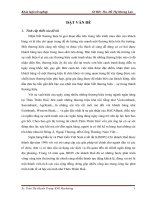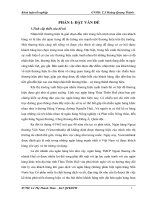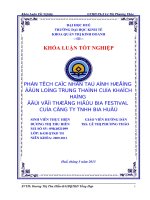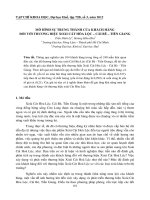điều tra ý định hành vi của khách hàng đối với thương mại xã hội
Bạn đang xem bản rút gọn của tài liệu. Xem và tải ngay bản đầy đủ của tài liệu tại đây (1.28 MB, 91 trang )
National Formosa University
Department of Information Management
Master Thesis
Investigating Customers' Behavioral Intention toward
Social Commerce: An Empirical Study in Vietnam
Graduate Student: Nguyen Thu Thao
Advisor: Dr. Chun-Hui Wu
January, 2015
Huwei, Yunlin, Taiwan, Republic of China
Investigating Customers' Behavioral Intention
toward Social Commerce: An Empirical Study
in Vietnam
Graduate Student: Nguyen Thu Thao
Advisor: Dr. Chun-Hui Wu
National Formosa University
Department of Information Management
Master Thesis
A Thesis Submitted to Department of Information Management
College of Management
National Formosa University
In Partial Fulfillment of the Requirements
For the Degree of Master of
Information Management
January, 2015
Huwei, Yunlin, Taiwan, Republic of China
Investigating Customers' Behavioral Intention toward
Social Commerce: An empirical Study in Vietnam
Student: Nguyen Thu Thao
Advisor: Chun-Hui Wu
Department of Information Management
National Formosa University
Abstract
Social commerce is gaining a rapid and wide popularity these days. Online
shopping has become increasingly popular in business development and the
number of new online stores is ever increasing. Many of these online stores,
however, fail for some reasons. Research indicated that one of the main reasons is
that consumer‟s do not trust online retailers. How to increase consumers‟ trust has
become an important issue in social commerce. A theoretical model was derived
based upon previous studies and the technology acceptance model (TAM), and nine
hypotheses were proposed to examine the relationships between constructs. Survey
method was employed for collecting data from 163 valid respondents in Viet Nam.
For testing theoretical hypotheses, structure equation modeling (SEM) was
conducted using maximum likelihood estimation in SmartPLS. Theoretical
contributions and practical implications on the finding were discussed and
suggestions for future study were presented.
Keywords: Social commerce, trust, technology acceptance model (TAM),
Structure equation modeling (SEM), SmartPLS
i
163
ΣmαρτΠΛΣ 2.0
, SmartPLS
ii
Acknowledgements
I would like to take this opportunity to express my sincere gratitude to all
those people who have made this dissertation possible and because of whom my
graduate experience has been one that I will cherish forever.
First of all, my deepest gratitude is to my advisor, Dr. Chun-Hui Wu. I have
been amazingly fortunate to have an advisor who gave me the freedom to explore
on my own and at the same time the guidance to recover when my steps faltered.
You taught me how to question thoughts and express ideas. Her patience and
support helped me overcome many crisis situations and finish this dissertation.
I also would like to give a special thank to Department of Information
Management of National Formosa University. Thanks for giving me the
opportunity and for their financial support during the period of two years. During
the two years, many friends were helpful to my color life. I have to acknowledge all
my classmates in the research room, for their assistance in many aspects that I
cannot list them all because of limited space. Also I would like to thank all the
respondents of the questionnaires.
Most importantly, none of this would have been possible without the love and
patience of my family. I would like to give my deeply thank to my Mom and my
family members who gave me the constant source of love, concern, support and
strength all two years to reach this goal. I would like to express my heartfelt
gratitude to my family. My extended family has aided and encouraged me
throughout this endeavor. Without their support, it was impossible for me to finish
my master thesis.
Huwei, January, 2015
Sincerely
Nguyen Thu Thao
iii
Table of Contents
Αβστραχτ.................................................................................................................... ι
........................................................................................................................ ιι
Αχκνοωλεδγεmεντσ ................................................................................................ ιιι
Ταβλε οφ Χοντεντσ ................................................................................................... ιϖ
Λιστ οφ Ταβλεσ .......................................................................................................... ϖι
Λιστ οφ φιγυρεσ ......................................................................................................... ϖιι
Χηαπτερ 1 Ιντροδυχτιον ............................................................................................ 1
1.1 Background .................................................................................................... 1
1.2 Research Motivation....................................................................................... 3
1.3 Research Question .......................................................................................... 4
1.4 Purpose .......................................................................................................... 5
1.5 Structure of the Thesis .................................................................................... 7
Χηαπτερ 2 Λιτερατυρε Ρεϖιεω .................................................................................... 8
2.1
The Field of Social Commerce................................................................... 8
2.1.1 Social Commerce –An introduction and Definition .................................. 8
2.1.2 Social commerce in Viet Nam .............................................................. 10
2.2
Trust related Theory in Social Commerce ................................................ 12
2.3
Technology Acceptance Model (TAM).................................................... 14
2.4
Social Presence Theory ............................................................................ 15
2.5
Enjoyment ............................................................................................... 16
2.6
Summary of the Literature Review .......................................................... 18
Χηαπτερ 3 Ρεσεαρχη Μετηοδολογψ ......................................................................... 19
3.1
Research Framework ............................................................................... 19
3.2
Research Hypotheses ............................................................................... 20
3.3
Research Method ..................................................................................... 22
iv
3.4
Data analysis ............................................................................................ 26
3.4.1 Research Reliability and Validity ......................................................... 26
3.4.2 Statistical Analysis ............................................................................... 27
3.5
Summary of the Research Methodology .................................................. 29
Χηαπτερ 4 Ρεσυλτσ .................................................................................................. 30
4.1 Respondents‟ Demographics ........................................................................ 30
4.2 Social Commerce Usage............................................................................... 32
4.3 Factor Analysis ............................................................................................ 34
4.4 Reliability Analysis ...................................................................................... 35
4.5 Hypotheses Testing ..................................................................................... 39
Χηαπτερ 5 Χονχλυσιονσ ........................................................................................... 44
5.1 Discussion ................................................................................................... 44
5.2 Conclusions ................................................................................................. 47
5.3 Limitation and Future Study ........................................................................ 49
Ρεφερενχεσ ............................................................................................................ 50
Αππενδιξ Ι Ενγλιση Θυεστιονναιρε ....................................................................... 57
Αππενδιξ ΙΙ ςιετναmεσε Θυεστιονναιρε .............................................................. 67
Εξτενδεδ Αβστραχτ ................................................................................................. 76
Ρεφερενχεσ ............................................................................................................ 82
Χυρριχυλυm ςιταε ................................................................................................... 83
v
List of Tables
Table 3.1 Measurement Scales ................................................................................. 23
Table 3.2 Cronbach's alpha Coefficient Consistency ............................................... 27
Table 3.3 KMO Values ............................................................................................. 28
Table 3.4 Standardized beta values for hypotheses testing ...................................... 28
Table 4.1 Respondents‟ demographic profile ........................................................... 31
Table 4.2 Using Experience of Social commerce Sites Frequently Visited ............. 33
Table 4.3 Frequency of activities in social commerce sites ..................................... 34
Table 4.4 KMO and Bartlett's Test Results .............................................................. 35
Table 4.5 Loadings and cross-loading of the measurement model .......................... 36
Table 4.6 Convergent validity and reliability test. ................................................... 37
Table 4.7 Discriminant validity test ......................................................................... 38
Table 4.8 Summary of hypotheses analysis ............................................................. 40
Table 4.9 Results of the hypotheses testing ............................................................. 41
vi









